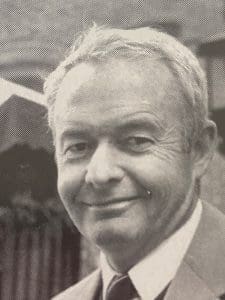
By Betty Jo Gigot Publisher
Editor’s Note: The four-part segment starting in the April 1996 CALF News feature on “The Quiet Giant” spotlighting Willian C. (Bill) Foxley was almost a road map of the development of the cattle feeding industry. As the business moved from California to Arizona to the Midwest, professionals like Foxley introduced new tools.
Foxley used his newly garnered knowledge from visiting the Southwest and, by 1963, had built his first feedyard near Omaha, Neb. His focus was on nutrition, and not only did he go from horses and wagons to trucks, he used computers to figure out breakevens and ration costs. In an effort to lock in a profit, he also used the futures market extensively.
“My father was the most brilliant man I ever met,” Foxley said. But he watched his father lose half of his net worth in 1952. “There was no safety net when cattle went from $36 per cwt. to $18 per cwt. in six months.”
By the mid 1960s, Foxley had bought a seat on the futures exchange and he found the safety net he had been looking for.
“When you bought cattle, and you were fairly sure that the breakeven would be $24 per cwt. in December, you could hedge them for $28,” he explained. “That built in a $40-per-head profit. It was just like falling off a log, year after year after year.”
The story went on to talk about Foxley making market history. “The speculators put the squeeze on and we made the first large delivery on the Merc. We delivered 300 loads to the Omaha Stockyards. I personally sorted the pens and they looked like peas in a pod. They were black baldies and were really nice cattle.” Foxley’s eyes twinkled as he said, “Boy, was that fun.”
Foxley went on to try to deal with the weather’s influence on feeding. He thought that, if weather was not a problem, all cattle would be fed in Iowa. He was very interested in totally enclosed yards and, in the mid 1960s had built a small barn to test his premise. He was glad it was small because it was a total disaster. Nothing worked right.
Five years later, he thought he had the right design and, in 1970, he built a 35,000-head confinement yard in Mead, Neb. In the 1980s, he went on to build the Bartlett lot with capacity for 54,000 head in barns and 11,000 outside. He designed them to use the best of the environment. In winter, the sun would shine all the way to the back of the barns, and in the summer, they were all in the shade. When asked is he would do any of it differently today, he said, “I would build them in Iowa, also.”
Heading into the early 1970s, Foxley had an inkling that trouble was coming. Corn prices had shot up and he thought the business was headed for a downturn. He decided to lay low. “We had 100 percent of the inventory hedged and that made me uneasy,” he said. “Eventually, the margin calls exceeded the debt limit. At first, the department head at the bank called me every day. Then it was the vice chairman. We really didn’t know but what they might go to a $100.”
As it turned out, Foxley was on the right side of the market and the next couple of years brought major changes to his business model. In 1974, Foxley sold the Mead feedlot and all of its assets to Flavorland for $5.5 million and 120,000 shares of Flavorland stock valued at $1.5 million.
As feeding prices soared, feeders held fat cattle and the industry saw one of the biggest crashes in its history. Meanwhile, Foxley not only weathered the crash, but was one of the few who showed black ink that year.
Next Issue: Onward






